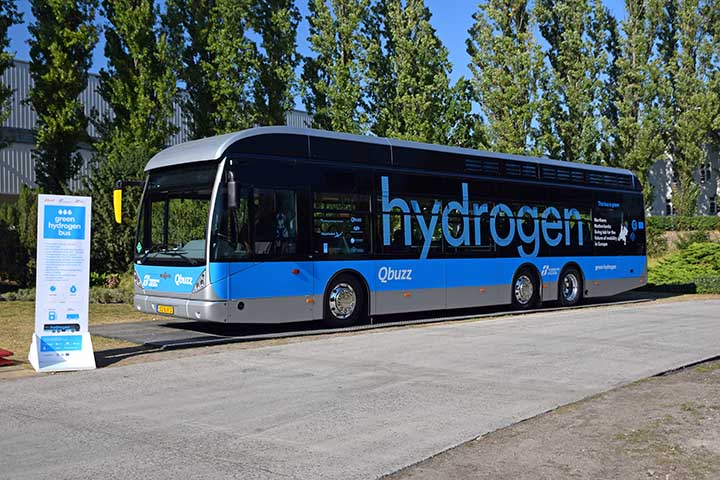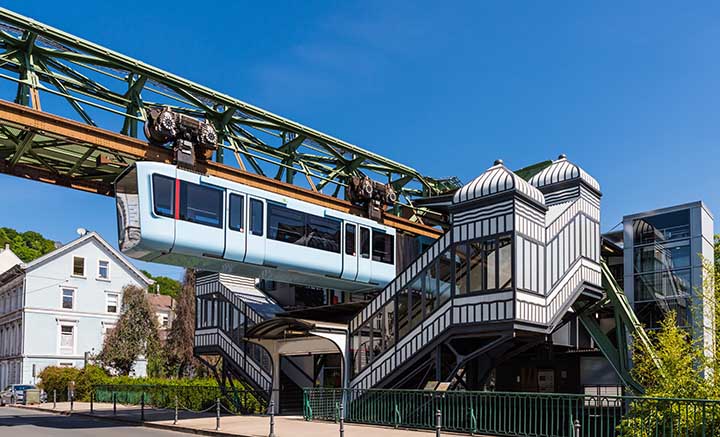Green Power Enables Green Hydrogen and Zero-Emissions Mobility
The post Green Power Enables Green Hydrogen and Zero-Emissions Mobility appeared first on POWER Magazine.

Wuppertal, in the German state of Nordrhein Westfahlen, is the home to the Schwebebahn. This suspended railway (Figure 1) is unique in Germany and passengers use the transportation system for 25 million journeys per year. Today, 120 years after Wuppertal's Schwebebahn opened, the city is still innovating. Green hydrogen produced from power generated by incineration of municipal waste will be used as an energy vector to power a fleet of fuel cell electric buses (FCEBs).
 1. The suspension railway in Wuppertal, North Rhine-Westphalia, Germany. Source: Shutterstock
1. The suspension railway in Wuppertal, North Rhine-Westphalia, Germany. Source: ShutterstockWilly Gortz, who leads the Projects department at AWG Abfallwirtschaftsgesellschaft mbH in Wuppertal (the city's waste collection and disposal organization), explained how the project began. The Energy and Waste sectors of the Wuppertal municipal services have worked together effectively for years. For example, we were awarded the first place in the Stadtwerke Award 2019. In this latest sector coupling initiative, we extended our collaboration to the public transportation team within the city. We need to decarbonize fully by 2050 and that's not so far off. We must get started right now with ambitious projects that can be replicated and scaled. Industry and power generation can have a big impact, but mobility and transportation must also make progress with fossil-fuel-free drive trains. Our project is taking a tangible step in this direction and we hope that it will be a beacon to light the way for others to follow."
This sector coupling concept, using hydrogen to link power generation and rubbish disposal to emissions-free public transport, is one of many projects underway in the Hydrogen Competence Region taking place in Wuppertal, Dusseldorf, and other towns in the state of Nordrhein Westfahlen, Germany.
Green Hydrogen from Low-Carbon PowerThe electrical power for the electrolysis that produces the hydrogen will be generated from the combustion of municipal solid waste (MSW). The Wuppertal waste incinerator burns more than 1,000 metric tons per day of MSW collected from local businesses and approximately 1.5 million people in the region. A fraction of the power generated by the incinerator will be used to charge the electrolyzer.
Households in Wuppertal use four bins for their waste: one for paper and cardboard, another for green waste from the garden or food scraps from the kitchen, a third for packaging such as plastic bags, and a fourth bin for everything else or Restmull." The paper, packaging, and green waste all go their separate ways for appropriate processing. Only the Restmull-the most difficult rubbish to dispose of in other ways-is used as feedstock to the waste incinerator.
Despite the removal of the green and paper material by the households, the Restmull from residents still has a biomass content of more than 50%. Using this feedstock and carbon dioxide emissions trading, the electricity generated on the Wuppertal waste incinerator can therefore be classified as green." This enables the hydrogen produced by the electrolyzer to carry the same environmentally friendly credentials.
The Wuppertal waste incinerator was purpose-built for power generation from the combustion of MSW. It entered service in 1976 and is fitted with two 20-MW and one 8-MW power generation turbines.
Gortz noted, The Wuppertal scheme is already planned to be replicated in the town of Herten, 50 kilometers (km) north of where we are in Wuppertal." Every year about 650,000 metric tons of domestic, trade, and industrial waste are burned in the RZR Herten waste incineration power station. This represents a significant contribution to a positive carbon dioxide balance because the operation of the waste power plant saves immense amounts of fossil fuels and therefore reduces the overall environmental impact of power generation in the region.
Put into operation in 1982, the Herten power station consists of six incineration lines, which ensures optimal thermal treatment of the MSW. To ensure that emissions are kept well under control, the flue gas scrubber incorporates a sophisticated filter that makes sure that the power plant's emissions are normally less than 10% of the legal limit.
As these regional schemes develop, hydrogen mobility applications could extend to the local taxi fleets as they convert to fuel cell electric vehicles. Dusseldorf airport could also become a low-emissions mobility zone with the conversion of 2,000 aviation logistics and materials handling vehicles, such as baggage cart tractors and airplane pushback tugs. These currently operate on diesel fuel, but the conversion of their power trains to hydrogen-powered fuel cells would be possible.
Prize-Winning InnovationThe DusselRheinWupper region was rewarded for its hard work toward a carbon-neutral future on October 15, 2020, winning the state competition for hydrogen mobility and subsequently obtaining the title as the Model Region for Hydrogen Mobility." The prize scheme was launched to increase the speed of the implementation of regional production and use of hydrogen in transport across North Rhine-Westphalia.
The Economics and Energy Minister of North Rhine-Westaphalia, Prof. Dr. Andreas Pinkwark, commented, Hydrogen is essential for reducing greenhouse gas emissions and for the success of the energy transition. Consistent use in transport and industry has made it possible to avoid a quarter of today's emissions. In addition to battery-electric mobility, fuel cell mobility with hydrogen will also play an important role in achieving climate targets in transport in the future. With our competition, we have been looking for a region or municipality that wants to take the lead in the implementation and application of hydrogen and fuel cell technologies in North Rhine-Westphalia with innovative approaches."
Driving Toward Zero-Emissions Mass TransportOne thousand buses operate in the region and many of them will switch from diesel power to emissions-free hydrogen as a fuel. The first A330 FC fuel cell and hydrogen-powered buses (Figure 2) arrived in Wuppertal in 2019 from the Belgian manufacturer Van Hool and more arrived in 2020. Each 12-m-long double-axle bus can carry 75 passengers and is equipped with an 85-kW Ballard Power Systems fuel cell to convert the hydrogen to motive force. For every ten FCEBs on the road, about 700 metric tons per year of carbon dioxide emissions from diesel fuel combustion can be eliminated.
 2. This Van Hool A330 fuel cell hydrogen bus was on display in Berlin, Germany, September 18, 2018. Source: Shutterstock
2. This Van Hool A330 fuel cell hydrogen bus was on display in Berlin, Germany, September 18, 2018. Source: ShutterstockIn the overall project budget of approximately 12 million, just over half will be allocated to the purchase of the new buses and the remainder has been allocated to the implementation of the hydrogen production, storage, and fueling system. The hydrogen for the FCEBs will be produced by a 1.25-MW electrolyzer, which has been supplied by the Canadian company Hydrogenics, part of Cummins Inc.
It uses a polymer electrolyte membrane (PEM) technology to generate high-purity hydrogen gas. The purity is important to ensure compatibility with the sensitive fuel cells on the buses. Impurities in the hydrogen can poison the fuel cell catalysts and inert gases, such as nitrogen, accumulate over time to degrade the fuel cell performance, leading to a loss of motive power for the vehicle.
The PEM technology is also ideal for applications where the electrolyzer needs to start up and shut down frequently-as is the case in concepts where electrolyzers are used only when the local electricity demand from other applications is low. This minimizes the level of stress on the power production and distribution grid, and ensures an environmentally and economically sustainable operation.
Integral to the system design is a high-pressure hydrogen gas buffer storage capacity of 425 kilograms. This storage enables faster fueling of multiple buses in rapid succession. It also means that the electrolyzer can be run intermittently, operating only at times when the cash value of exporting electricity to the local grid is low. This means that the hydrogen production equipment is slightly oversized compared to a system that would operate continuously, but it makes the overall system economics significantly more attractive and improves the value of the investment in the mid- and long-term.
High-Pressure Hydrogen-Energy Density for Efficient MobilityThe gas compression system and fueling dispensers for the hydrogen supply have been manufactured by Maximator GmbH at its factory in Nordhausen, approximately 300 km due east of Wuppertal in the German state of Thuringen. Maximator also played the leading role in the hydrogen production, storage, and fueling concept design; systems integration; and project management. Gortz added, We chose to offer this project to Maximator because their system had the highest uptime availability and represented the best value for the money."
The company recognizes the importance of having capabilities in delivering large quantities of hydrogen to vehicles in rapid succession. Mathias Kurras, head of Maximator's Hydrogen division, declared his support for the Hydrogen Kompetenz Region" in the area of Dusseldorf and Wuppertal: We are thrilled that the green energy potential of hydrogen will be further unlocked through this visionary sector coupling project at Wuppertal and the associated hydrogen mobility infrastructure development program that it will enable."
Maximator has interests in high-pressure testing, components, and hydraulics. Its fueling station utilizes two stages of hydrogen compression with a gas intercooler between the stages, allowing for maximum efficiency within the system. With the high-pressure gas seal, which can withstand 13,500 psi (900 bar), the maintenance of the seal is automated, allowing the system to run with ease.
In the past, across all fueling station manufacturers, changing out the gasket was a time-consuming process that meant the fueling station must be taken offline for a day or more. For pilot stations, that has been tolerated either by the acceptance of the downtime or the use of a second fueling station to build redundancy into the system-at a significant cost. But as hydrogen fueling stations become an integral part of the world's mobility infrastructure, they must compete with traditional diesel and gasoline pumps and offer 99% availability or better.
Maximator's solution holds multiple high-pressure sealing gaskets that are automatically loaded into the hydrogen fueling station gas compressor as required. To fully automate the process, a sensitive hydrogen gas detection system is integrated into the design. It can measure the high-pressure seal leakage rate and determine the optimal timing for the gasket replacement.
One benefit of the automated gasket changeover system is a significant increase in availability. It also leads to a large decrease in maintenance costs due to a significant reduction in the frequency of service team visits to the fueling station-typically only one-quarter of the service manpower and travel time compared to other technologies. These points directly address two of the main challenges the hydrogen fueling station technology has faced in the past.
-Stephen B. Harrison is managing director of sbh4 GmbH, and Daniel W. Harker is sbh4's research analyst.
The post Green Power Enables Green Hydrogen and Zero-Emissions Mobility appeared first on POWER Magazine.